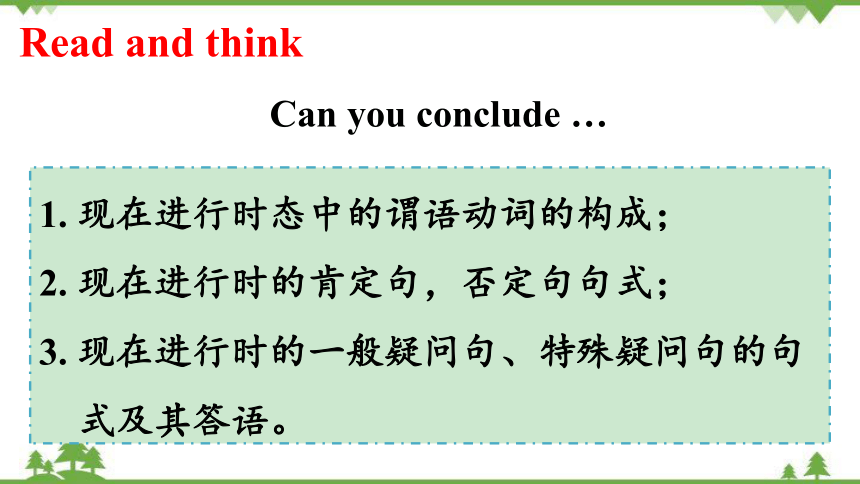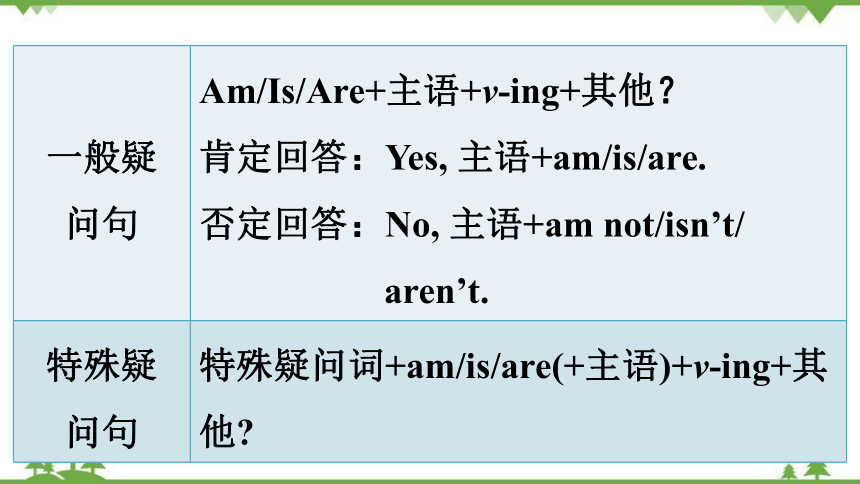Unit 6 I’m watching TV.Section A(Grammar Focus-3c)课件(共30张PPT)
文档属性
| 名称 | Unit 6 I’m watching TV.Section A(Grammar Focus-3c)课件(共30张PPT) |  | |
| 格式 | ppt | ||
| 文件大小 | 1.0MB | ||
| 资源类型 | 教案 | ||
| 版本资源 | 人教新目标(Go for it)版 | ||
| 科目 | 英语 | ||
| 更新时间 | 2022-06-13 15:42:21 | ||
图片预览












文档简介
(共30张PPT)
Unit 6 I’m watching TV.
Section A
(Grammar Focus-3c)
Learning objects
By the end of the class, you will be able to …
1. Learn curriculum words and useful expressions.
2. Master the different sentence patterns of the
present progressive tense.
3. Talk about what people are doing using the
present progressive tense.
Watch and sing
What are you doing I’m watching TV.
What’s she doing She’s washing her clothes.
What are they doing They’re listening to a CD.
Are you doing your homework Yes, I am. / No, I’m not. I’m cleaning my room.
Is he reading a newspaper Yes, he is. / No, he isn’t. He’s playing basketball.
Are they using the computer Yes, they are. / No, they aren’t. They’re exercising.
Grammar Focus
Read and think
Can you conclude …
1. 现在进行时态中的谓语动词的构成;
2. 现在进行时的肯定句,否定句句式;
3. 现在进行时的一般疑问句、特殊疑问句的句
式及其答语。
现在进行时
定义
现在进行时表示现在正在进行的动作,也可表示现阶段正在进行的动作。
构成
be动词(am/is/are)+动词-ing形式
be 动词的形式要与主语的人称和数保持一致。
句型结构
肯定句 主语+am/is/are+v-ing+其他.
否定句 主语+am not/isn’t/aren’t+v-ing+其他.
一般疑
问句 Am/Is/Are+主语+v-ing+其他?
肯定回答:Yes, 主语+am/is/are.
否定回答:No, 主语+am not/isn’t/
aren’t.
特殊疑
问句 特殊疑问词+am/is/are(+主语)+v-ing+其他
verb v-ing verb v-ing
watching using
cleaning making
reading washing
talking exercising
listening
watch
clean
read
talk
listen
use
make
wash
exercise
Look and think
动词原形如何变成现在分词?有什么规律?
v-ing变化规律
一般情况下,在动词词尾直接加-ing do → doing
buy → buying
以不发音的字母e结尾的动词,
去掉e,再加-ing have → having
dance → dancing
以重读闭音节结尾且末尾只有一个辅音字母的动词,双写末尾辅音字母,再加 -ing swim → swimming
shop → shopping
少数以 ie 结尾的动词,变 ie为 y,再加 -ing die → dying
lie → lying
Let’s write
写出下列动词的-ing形式
sing → _______ paint → ________
study → ________ play → _______
write → _______ draw → _______
take → ______ get → _______
begin → _________ put → _______
singing
painting
studying
playing
writing
drawing
taking
getting
beginning
putting
判定时态的方法
当句中有时间状语 now, right now, at the moment (正在此刻)等时,常表示动作正在进行,要用现在进行时。
现在海伦正在听音乐。
Helen is listening to music now.
如果前面有look, listen等提示性语言时,暗示下一句的动作正在进行,要用现在进行时。
看!我的妈妈正在给我做新连衣裙。
Look! My mother is making a new dress for me.
Read and think
Simple Present Tense Present Progressive Tense
I often watch TV. I am watching TV now.
She often watches TV. She is watching TV now.
They often watch TV. They are watching TV now.
Do you often watching TV Are you watching TV now
1. 左栏例句中谓语部分的结构与右栏例句的谓语结构有何不同?
2. 两栏例句中各使用的时间状语有何不同?
3. 这两栏例句各表达什么概念?
Present Progressive Tense Simple Present Tense
用法 现在进行时表示现在正在进行或发生的动作。 一般现在时表示现在的状态,经常的或习惯性的动作。
构成 be(am/is/are)+doing(动词-ing形式) do/does
时间状语 now on Monday, every day/night, in the morning/afternoon, after dinner/school, on weekends, usually, often, sometimes …
Exercise
1. Look! The boys _________ (play) basketball on
the playground.
2. My father __________(read) books after dinner.
3. In the morning, Mr. Smith __________(get) up
at seven o’clock.
4. Listen! Linda ________(sing) in the next room.
is playing
reads
gets
is singing
根据语境及括号内的动词填空。
5. His brother usually __________(do) homework
at school.
6. They __________(go) shopping every Friday
evening.
7. Her sister __________(eat) dinner now.
8. On weekends Aunt Beth __________(walk)
with her pet dog.
does
go
is eating
walks
按要求完成句子,每空一词(含缩略词)。
1. He is reading a newspaper in the living room.
(改为一般疑问句)
____ ____ ________ a newspaper in the living
room
2. Tony is taking a shower. (对画线部分提问)
______ ____ Tony ______
Is he reading
What is
doing
3. Are you dancing, Cindy (作否定回答)
____, ____ ____.
4. Jenny is singing in the classroom. (对画线部分
提问)
____ ____ singing in the classroom
5. Mary eats an apple every day. (用now替换
every day改写句子)
Mary ____ ______ ____ ______ ____.
No I’m not
Who is
is eating an apple now
3a
Write sentences following the examples.
1. Jenny/ clean the house/ now
_________________________________
2. Bob/ make dinner/ every Saturday
_________________________________
Jenny is cleaning the house now.
Bob makes dinner every Saturday.
3. Mary’s parents/ drink tea/ after dinner
________________________________________
4. Bill/ talk on the phone/ now
________________________________________
5. Becky and Bob/watch TV / on weekends
________________________________________
Mary’s parents drink tea after dinner.
Bill is talking on the phone now.
Becky and Bob watch TV on weekends.
Pair work
Make a dialogue according to 3a.
What’s Jenny doing now
She is cleaning the house now.
What does Bob do every Saturday
He makes dinner every Saturday.
3b
Number the sentences in order to make a
telephone conversation. Then practice it with a partner.
____ Do you want to go tomorrow then
____ OK. See you tomorrow evening!
____ I’m reading a book.
____ Let’s go at seven o’clock.
____ No, this book is really interesting.
____ What are you doing
____ Do you want to go to the movies now
____ Sure, what time
5
8
2
7
4
1
3
6
3c
Take turns miming different activities in your group. The others in the group guess what the activities are.
No, I’m not.
Yes, you’re right.
Are you
making soup
Are you
cleaning
Group work
Three students in a group. One student acts. Other two students talk about his actions.
A: Is he/she doing …
B: No, I don’t think so. Is he/she …
A: Maybe. Let’s ask him/ger.
Summary
The different sentence patterns and the adverbials of time in the present progressive tense.
The difference between the present progressive tense and the simple present tense.
Unit 6 I’m watching TV.
Section A
(Grammar Focus-3c)
Learning objects
By the end of the class, you will be able to …
1. Learn curriculum words and useful expressions.
2. Master the different sentence patterns of the
present progressive tense.
3. Talk about what people are doing using the
present progressive tense.
Watch and sing
What are you doing I’m watching TV.
What’s she doing She’s washing her clothes.
What are they doing They’re listening to a CD.
Are you doing your homework Yes, I am. / No, I’m not. I’m cleaning my room.
Is he reading a newspaper Yes, he is. / No, he isn’t. He’s playing basketball.
Are they using the computer Yes, they are. / No, they aren’t. They’re exercising.
Grammar Focus
Read and think
Can you conclude …
1. 现在进行时态中的谓语动词的构成;
2. 现在进行时的肯定句,否定句句式;
3. 现在进行时的一般疑问句、特殊疑问句的句
式及其答语。
现在进行时
定义
现在进行时表示现在正在进行的动作,也可表示现阶段正在进行的动作。
构成
be动词(am/is/are)+动词-ing形式
be 动词的形式要与主语的人称和数保持一致。
句型结构
肯定句 主语+am/is/are+v-ing+其他.
否定句 主语+am not/isn’t/aren’t+v-ing+其他.
一般疑
问句 Am/Is/Are+主语+v-ing+其他?
肯定回答:Yes, 主语+am/is/are.
否定回答:No, 主语+am not/isn’t/
aren’t.
特殊疑
问句 特殊疑问词+am/is/are(+主语)+v-ing+其他
verb v-ing verb v-ing
watching using
cleaning making
reading washing
talking exercising
listening
watch
clean
read
talk
listen
use
make
wash
exercise
Look and think
动词原形如何变成现在分词?有什么规律?
v-ing变化规律
一般情况下,在动词词尾直接加-ing do → doing
buy → buying
以不发音的字母e结尾的动词,
去掉e,再加-ing have → having
dance → dancing
以重读闭音节结尾且末尾只有一个辅音字母的动词,双写末尾辅音字母,再加 -ing swim → swimming
shop → shopping
少数以 ie 结尾的动词,变 ie为 y,再加 -ing die → dying
lie → lying
Let’s write
写出下列动词的-ing形式
sing → _______ paint → ________
study → ________ play → _______
write → _______ draw → _______
take → ______ get → _______
begin → _________ put → _______
singing
painting
studying
playing
writing
drawing
taking
getting
beginning
putting
判定时态的方法
当句中有时间状语 now, right now, at the moment (正在此刻)等时,常表示动作正在进行,要用现在进行时。
现在海伦正在听音乐。
Helen is listening to music now.
如果前面有look, listen等提示性语言时,暗示下一句的动作正在进行,要用现在进行时。
看!我的妈妈正在给我做新连衣裙。
Look! My mother is making a new dress for me.
Read and think
Simple Present Tense Present Progressive Tense
I often watch TV. I am watching TV now.
She often watches TV. She is watching TV now.
They often watch TV. They are watching TV now.
Do you often watching TV Are you watching TV now
1. 左栏例句中谓语部分的结构与右栏例句的谓语结构有何不同?
2. 两栏例句中各使用的时间状语有何不同?
3. 这两栏例句各表达什么概念?
Present Progressive Tense Simple Present Tense
用法 现在进行时表示现在正在进行或发生的动作。 一般现在时表示现在的状态,经常的或习惯性的动作。
构成 be(am/is/are)+doing(动词-ing形式) do/does
时间状语 now on Monday, every day/night, in the morning/afternoon, after dinner/school, on weekends, usually, often, sometimes …
Exercise
1. Look! The boys _________ (play) basketball on
the playground.
2. My father __________(read) books after dinner.
3. In the morning, Mr. Smith __________(get) up
at seven o’clock.
4. Listen! Linda ________(sing) in the next room.
is playing
reads
gets
is singing
根据语境及括号内的动词填空。
5. His brother usually __________(do) homework
at school.
6. They __________(go) shopping every Friday
evening.
7. Her sister __________(eat) dinner now.
8. On weekends Aunt Beth __________(walk)
with her pet dog.
does
go
is eating
walks
按要求完成句子,每空一词(含缩略词)。
1. He is reading a newspaper in the living room.
(改为一般疑问句)
____ ____ ________ a newspaper in the living
room
2. Tony is taking a shower. (对画线部分提问)
______ ____ Tony ______
Is he reading
What is
doing
3. Are you dancing, Cindy (作否定回答)
____, ____ ____.
4. Jenny is singing in the classroom. (对画线部分
提问)
____ ____ singing in the classroom
5. Mary eats an apple every day. (用now替换
every day改写句子)
Mary ____ ______ ____ ______ ____.
No I’m not
Who is
is eating an apple now
3a
Write sentences following the examples.
1. Jenny/ clean the house/ now
_________________________________
2. Bob/ make dinner/ every Saturday
_________________________________
Jenny is cleaning the house now.
Bob makes dinner every Saturday.
3. Mary’s parents/ drink tea/ after dinner
________________________________________
4. Bill/ talk on the phone/ now
________________________________________
5. Becky and Bob/watch TV / on weekends
________________________________________
Mary’s parents drink tea after dinner.
Bill is talking on the phone now.
Becky and Bob watch TV on weekends.
Pair work
Make a dialogue according to 3a.
What’s Jenny doing now
She is cleaning the house now.
What does Bob do every Saturday
He makes dinner every Saturday.
3b
Number the sentences in order to make a
telephone conversation. Then practice it with a partner.
____ Do you want to go tomorrow then
____ OK. See you tomorrow evening!
____ I’m reading a book.
____ Let’s go at seven o’clock.
____ No, this book is really interesting.
____ What are you doing
____ Do you want to go to the movies now
____ Sure, what time
5
8
2
7
4
1
3
6
3c
Take turns miming different activities in your group. The others in the group guess what the activities are.
No, I’m not.
Yes, you’re right.
Are you
making soup
Are you
cleaning
Group work
Three students in a group. One student acts. Other two students talk about his actions.
A: Is he/she doing …
B: No, I don’t think so. Is he/she …
A: Maybe. Let’s ask him/ger.
Summary
The different sentence patterns and the adverbials of time in the present progressive tense.
The difference between the present progressive tense and the simple present tense.
同课章节目录
- Unit 1 Can you play the guitar?
- Section A
- Section B
- Unit 2 What time do you go to school?
- Section A
- Section B
- Unit 3 How do you get to school?
- Section A
- Section B
- Unit 4 Don't eat in class.
- Section A
- Section B
- Unit 5 Why do you like pandas?
- Section A
- Section B
- Unit 6 I'm watching TV.
- Section A
- Section B
- Review of Units 1-6
- Unit 7 It's raining!
- Section A
- Section B
- Unit 8 Is there a post office near here?
- Section A
- Section B
- Unit 9 What does he look like?
- Section A
- Section B
- Unit 10 I'd like some noodles.
- Section A
- Section B
- Unit 11 How was your school trip?
- Section A
- Section B
- Unit 12 What did you do last weekend?
- Section A
- Section B
